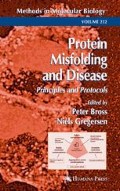Abstract
The example used in this chapter concerns the group of autosomal recessive inherited peroxisome biogenesis disorders (PBDs). These disorders are genetically heterogeneous with at least 12 different complementation groups (CGs). CG 1 is the largest characterized by mutations in HsPEX1, a gene encoding a 143 kD AAA protein (ATPases associated with diverse cellular activities) (1–3). About 65% of the PBD patients suffering from peroxisome biogenesis disorders harbor mutations in PEX1 (4–6). Although the function of PEX1 is not defined yet, it is likely that PEX1 plays a significant role in the import of peroxisomal matrix proteins from the cytosol—where they are translated—into the peroxisomes (1,2,7,8).
Access this chapter
Tax calculation will be finalised at checkout
Purchases are for personal use only
References
Reuber, B. E., Germain-Lee, E., Collins, C. S., Morrell, J. C., Ameritunga, R., Moser, H. W., et al. (1997) Mutations in PEX1 are the most common cause of peroxisome biogenesis disorders. Nat. Genet. 17, 445–448.
Portsteffen, H., Beyer, A., Becker, E., Epplen, C., Pawlak, A., Kunau, W.-H., and Dodt, G. (1997) Human PEX1 is mutated in complementation group 1 of the peroxisome biogenesis disorders. Nat. Genet. 17, 449–452.
Tamura, S., Okumoto, K., Toyama, R., Shimozawa, N., Tsukamoto, T., Suzuki, Y., et al. (1998) Human PEX1 cloned by functional complementation on a CHO cell mutant is responsible for peroxisome-deficient Zellweger syndrome of complementation group I. Proc. Natl. Acad. Sci. USA 95, 4350–4355.
Moser, A. B., Rasmussen, M., Naidu, S., Watkins, P. A., McGuinness, M., Hajra, A. K., et al. (1995) Phenotype of patients with peroxisomal disorders subdivided into sixteen complementation groups. J. Pediatr. 127, 13–22.
Wanders, R. J., Mooijer, P. A., Dekker, C., Suzuki, Y., and Shimozawa, N. (1999) Disorders of peroxisome biogenesis: complementation analysis shows genetic heterogeneity with strong overrepresentation of one group (PEX1 deficiency). J. Inherit. Metab. Dis. 22, 314–318.
Maxwell, M. A., Nelson, P. V., Chin, S. J., Paton, B. C., Carey, W. F., and Crane, D. I. (1999) A common PEX1 frameshift mutation in patients with disorders of peroxisome biogenesis correlates with the severe Zellweger syndrome phenotype. Hum. Genet. 105, 38–44.
Collins, C. S., Kalish, J. E., Morrell, J. C., McCaffery, J. M., and Gould, S. J. (2000) The peroxisome biogenesis factors pex4p, pex22p, pex1p, and pex6p act in the terminal steps of peroxisomal matrix protein import. Mol. Cell Biol. 20, 7516–7526.
Sacksteder, K. A. and Gould, S. J. (2000) The genetics of peroxisome biogenesis. Annu. Rev. Genet. 34, 623–652.
Imamura, A., Tamura, S., Shimozawa, N., Suzuki, Y., Zhang, Z., Tsukamoto, T., et al. (1998) Temperature-sensitive mutation in PEX1 moderates the phenotypes of peroxisome deficiency disorders. Hum. Mol. Genet. 7, 2089–2094.
Gärtner, J., Preuss, N., Brosius, U., and Biermanns, M. (1999) Mutations in PEX1 in peroxisome biogenesis disorders: G843D and a mild clinical phenotype. J. Inherit. Metab. Dis. 22, 311–313.
Collins, C. S. and Gould, S. J. (1999) Identification of a common PEX1 mutation in Zellweger syndrome. Hum. Mutat. 14, 45–53.
Waters, P. J., Parniak, M. A., Akerman, B. R., and Scriver, C. R. (2000) Characterization of phenylketonuria missense substitutions, distant from the phenylalanine hydroxylase active site, illustrates a paradigm for mechanism and potential modulation of phenotype. Mol. Genet. Metab. 69, 101–110.
Waters, P. J., Parniak, M. A., Hewson, A. S., and Scriver, C. R. (1998) Alterations in protein aggregation and degradation due to mild and severe missense mutations (A104D, R157N) in the human phenylalanine hydroxylase gene (PAH). Hum. Mutat. 12, 344–354.
Bross, P., Corydon, T. J., Andresen, B. S., Jorgensen, M. M., Bolund, L., and Gregersen, N. (1999) Protein misfolding and degradation in genetic diseases. Hum. Mutat. 14, 186–198.
Walter, C., Gootjes, J., Mooijer, P. A., Portsteffen, H., Klein, C., Waterham, H. R., et al. (2001) Disorders of peroxisome biogenesis due to mutations in PEX1: phenotypes and PEX1 protein levels. Am. J. Hum. Genet. 69, 35–48.
Lazarow, P. B., Robbi, M., Fujiki, Y., and Wong, L. (1982) Biogenesis of peroxisomal proteins in vivo and in vitro. Ann. NY Acad. Sci. 386, 285–300.
Warren, D. S., Morrell, J. C., Moser, H. W., Valle, D., and Gould, S. J. (1998) Identification of PEX10, the gene defective in complementation group 7 of the peroxisome-biogenesis disorders. Am. J. Hum. Genet. 63, 347–359.
Tamura, S., Matsumoto, N., Imamura, A., Shimozawa, N., Suzuki, Y., Kondo, N., and Fujiki, Y. (2001) Phenotype-genotype relationships in peroxisome biogenesis disorders of PEX1-defective complementation group 1 are defined by Pex1p-Pex6p interaction. Biochem. J. 357, 417–426.
Author information
Authors and Affiliations
Editor information
Editors and Affiliations
Rights and permissions
Copyright information
© 2003 Humana Press Inc., Totowa, NJ
About this protocol
Cite this protocol
Dodt, G., Walter, C. (2003). Study of Mutant Proteins With Folding Defects in Cultured Patient Cells. In: Bross, P., Gregersen, N. (eds) Protein Misfolding and Disease. Methods in Molecular Biology™, vol 232. Humana Press. https://doi.org/10.1385/1-59259-394-1:165
Download citation
DOI: https://doi.org/10.1385/1-59259-394-1:165
Publisher Name: Humana Press
Print ISBN: 978-1-58829-065-6
Online ISBN: 978-1-59259-394-1
eBook Packages: Springer Protocols

